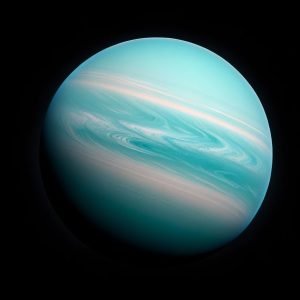 1. Uranus is named after the Greek god of the sky. Uranus was the husband of Gaia, the goddess of the Earth.
1. Uranus is named after the Greek god of the sky. Uranus was the husband of Gaia, the goddess of the Earth.
2. It was discovered in December 13, 1781 by William Herschel, a German-born British astronomer.
3. The orbital speed of Uranus is 6.6 km/sec (14,763 mi/hr).
4. A year on Uranus is equal to 84.01 Earth Years (orbit around the sun).
5. Uranus is the third largest planet in the Solar System.
6. The atmosphere of Uranus is composed of hydrogen, helium, and methane. The methane in the atmosphere absorbs red light, giving the planet a blue-green color.
7. Uranus is considered unusual because the planet is tipped on its side. The poles actually point towards the Sun. This is due to the fact that its magnetic field is tilted 60 degrees from the axis of rotation.
8. In 1986, Voyager 2 visited Uranus, until then, little was known about this planet.
9. Like Venus, Uranus spins from east to west, which is opposite from the spin of Earth.
10. A day on Uranus is equal to a little more than 17 hours on Earth.
11. Uranus maximum distance from the Sun is 3 billion km (1.88 billion miles).
12. Uranus minimum distance from the Earth is 2.6 billion km (1.6 billion miles).
13. The diameter of Uranus is 51,488 km (32,000 miles).
14. The 27 moons of Uranus are named after characters created by William Shakespeare and Alexander Pope.
15. William Herschel identified Titania and Oberon in 1787, these are the first two moons of Uranus that were discovered.
16. Uranus has 13 unique rings. They are named using Greek symbols and other numerical values: 1986U2R/ζ, 6, 5, 4, α, β, η, γ, δ, λ, ε, ν, and μ.
17. If you weigh 100 lbs on earth, your weight on Uranus would be 89 lbs. (multiply your actual weight by 0.89).
18. Miranda, Ariel, Umbriel, Titania, and Oberon are the main satellites of Uranus. Miranda & Ariel are characters in Shakespeare’s “The Tempest”; Ariel & Umbriel are also a characters in Alexander Pope’s “The Rape of the Lock”; Titania & Oberon are fairy royalty in Shakespeare’s “The Midsummer Nights Dream.”
19. Uranium, the chemical element, is named after the planet Uranus by Martin Heinrich Klaproth, a German chemist, in 1789.
20. Due to the fashion in which it spins, portions of Uranus can have nights that last over 40 years.
21. Uranus is the coldest of the planets even though Neptune is located further from the Sun.
22. The planet is the second least dense after Saturn.
